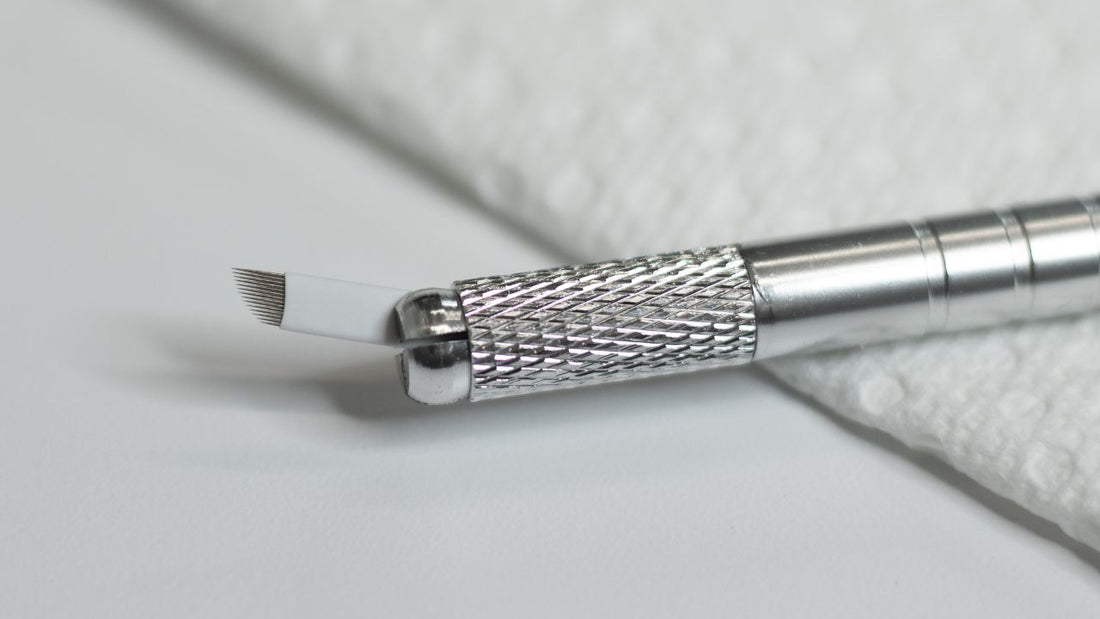
How to Choose the Right Microblade for Flawless PMU Results
A Girlz Ink Guide to Microblading and Manual Shading Needles
When it comes to microblading, the blade you choose matters. With so many options—U-blades, curved blades, flat and round shaders—it’s easy to feel overwhelmed. But don’t stress, Babe. Once you understand how each needle works, choosing the right one becomes second nature.
Whether you're just getting started or refining your signature brow style, this guide breaks down the different microblade configurations, needle groupings, and diameter sizes—so you can create stunning results on every skin type.
Microblade and Manual Shader Types Explained
Let’s start with the basics. Below are the most common microblade and shader types and what they’re best used for.
✨ U-Blades
U-blades are shaped like a “U,” with shorter needles at the ends and longer ones in the middle. This shape creates curved, fluid hair strokes—ideal for bulb strokes, Phi-style patterns, and back-and-forth etching. But heads up: they’re sharp on both ends, so beginners should practice on latex before working on skin.
💡 Pro Tip: Always test any new blade on practice skin first to build your muscle memory.
✨ Curved Blades (AKA CF, Slant, or Angled Blades)

These are the OGs of microblading—your go-to blade for natural, beautiful hair strokes. Available in a range of needle (pin) counts, they allow you to customize your strokes based on the look you're creating.
🩷 Use fewer pins for detail work.
🩷 More pins = longer, fuller strokes.
You’ll find curved blades in most artist kits—and for good reason. They’re versatile, reliable, and easy to fall in love with.
Shay Danielle Microblading Needles in picture.
✨ Flat Shaders
Flat shaders are perfect for outlining or shading tight areas like the tail of the brow. Their flat, narrow design lets you get precise in smaller spaces without overworking the skin.
✨ Round Shaders
These babies are your go-to for bigger areas of shading. Larger groupings implant pigment quickly and evenly, reducing trauma and giving a soft, dispersed effect. Use smaller groupings—like 1 to 3 pin shaders—for delicate areas like the bulb or to create a pointillism effect.
✨ Double Row Shaders
Need to cover more ground? Double row shaders feature two straight rows of flat needles and are ideal for shading both narrow and wide sections of the brow.
How Needle Count Impacts Your Stroke Length
The number of needles in your microblade directly impacts the length and look of your hair strokes. Here's a quick breakdown to guide your selection:
| Pins (Needles) | Best For |
|---|---|
| 7–9 Pins | Short, detailed strokes; touch-ups; adding fullness |
| 12 Pins | Medium-length strokes; the universal size most artists love |
| 14–17 Pins | Long strokes; building the brow outline or skeleton; fuller brow designs |
Choosing the Right Blade Diameter for Every Skin Type
Skin isn’t one-size-fits-all—and neither are your tools. The diameter of your blade affects how it performs on different skin textures. Here’s how to match blade diameter to skin type for optimal healed results:
| Skin Type | Recommended Diameter | Why |
|---|---|---|
| Thin, fragile, mature skin | .18 mm | Less trauma, more precision |
| Normal skin | .20–.25 mm | Balanced pigment deposit and control |
| Thick or textured skin | .25–.30 mm | More strength and penetration |
💡 Reminder: Clients with sun-damaged, rosacea-prone, or retinol-treated skin may benefit from thinner diameters to reduce irritation and ensure beautiful healed results.
The Bottom Line: Choose with Confidence
There’s no one-size-fits-all blade. Whether you’re a U-blade queen, a slant blade slayer, or a shader lover, there’s a tool that fits your style and your client’s skin.
Want to see what’s available?
🛍️ Shop Microblading Needles on the Girlz Ink Store!
Explore top brands like Jenn Boyd’s Brow Slayer, Mei-Cha, and Softap—each offering a wide variety of shapes, sizes, and configurations to match your artistry.

FAQ: Choosing the Right Microblade
Q: What’s the best microblade for beginners?
A: A 12-pin curved blade is a great starting point. It’s easy to control and works well for most clients.
Q: How often should I change blades during a procedure?
A: One blade per client. Never reuse blades. If it dulls during a session, swap it out.
Q: What’s the difference between curved and U-blades?
A: Curved blades offer clean, slanted strokes. U-blades give more curvature and fluid motion, but require extra control.
Q: Can I use the same blade for all skin types?
A: You can, but you shouldn’t. Match blade diameter to skin type for best results and happy healed brows.
